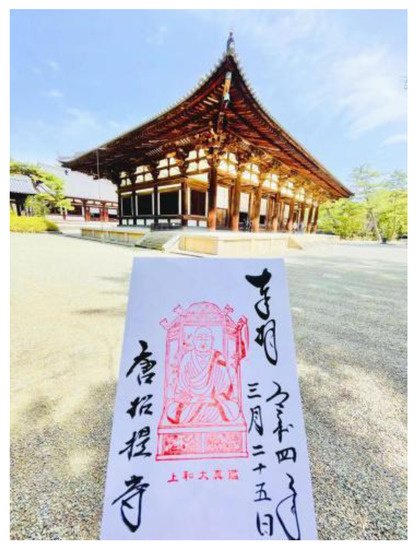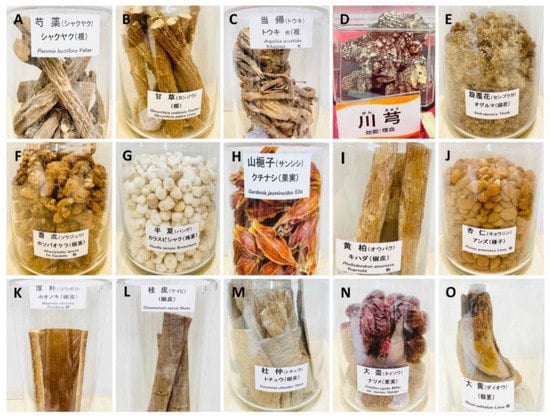Japanese Kampo medicine has its origin in ancient Chinese medicine. In 742, a Tang Dynasty monk named Jianzhen (Ganjin) was invited by Japanese clerics to visit Japan and teach commandments in Buddhism. Because of the dangers of the voyage and also other obstacles, he took 11 years to reach Japan on the sixth voyage and he was blind when he arrived in Japan. He was the first person in China to go to Japan to establish the Buddhism commandments, and he was also the first person in Japan to directly teach traditional Chinese medicine. Until now, there have been few reports in English about the details of the Chinese herbal medicines he brought to Japan, including the types of herbal medicines, pharmacological activities, and formulations.
- Jianzhen
- Ganjin
- traditional Chinese medicine
- Kampo medicine
- herbal medicine
- medical history
- Toshodaiji Temple
- traditional Japanese medicine
- Nara
- Tang Dynasty
1. Introduction

2. Jianzhen’s Background in Medicine and Pharmacy

3. Traditional Chinese Medicines Brought to Japan

| NO. | Names of Herbs (Pinyin, Chinese and English Name) | Pharmacological Activities | References |
|---|---|---|---|
| 1 | Ma Huang (麻黄, Ephedra sinica Stapf) | treats asthma, bronchitis, and hay fever, etc. | [10] |
| 2 | Xi Xin (細辛, Asarum heterotropoides) | dispels cold, reduces phlegm, and relieves pain, etc. | [11] |
| 3 | Shao Yao (芍薬, Paeonia lactiflora Pall) | treats pain, immune disorders, and inflammation, etc. | [12] |
| 4 | Fu Zi (附子, Aconitum carmichaeli Debeaux) | treats rheumatic fever, some endocrine disorders, and painful joints, etc. | [13] |
| 5 | Yuan Zhi (遠志, Polygala senega L.) | anti-oxidative, anti-inflammatory, anti-aging, neuroprotective, hypnotic-sedative, anti-viral, anti-tumor, anti-arrhythmic, and anti-depressant effects, etc. | [14] |
| 6 | Huang Qi (黄芪, Astragalus mongholicus Bunge ) | anti-viral, immunomodulatory, and anti-cancer effects, etc. | [15] |
| 7 | Gan Cao (甘草, Glycyrrhiza glabra L.) | treats cough, phlegm, dyspnea, spasms, and pain, etc. | [16] |
| 8 | Ku Shen (苦参, Sophora flavescens Aiton) | anti-inflammatory, anti-microbial, anti-pyretic, anti-nociceptive, and anti-tumor effects, etc. | [17] |
| 9 | Dang Gui (当帰, Angelica sinensis (Oliv.) Diels) | tonifies, invigorates blood, lubricates the intestines, relieves pain, treats female amenorrhea and irregular menstruation, etc. | [18] |
| 10 | Chai Hu (柴胡, Bupleurum falcatum L.) | treats cold fever, irregular menstruation, uterine prolapse, rectocele, chest and rib swelling pain, etc. | [19] |
| 11 | Chuan Xiong (川芎, Conioselinum anthriscoides ‘Chuanxiong’) | anti-inflammatory, anti-oxidative, anti-cerebral ischemia, anti-hypertensive, blood vessel protection, anti-myocardial ischemia, anti-thrombotic, anti-atherosclerosis, anti-spasmodic, anti-asthma, and anti-cancer effects, etc. | [20] |
| 12 | Xuan Shen (玄参, Scrophularia ningpoensis Hemsl.) | neuroprotective, anti-inflammatory, anti-ventricular remodeling and hepatoprotective effects, etc. | [21] |
| 13 | Di Huang (地黄, Rehmannia glutinosa (Gaertn.) DC.) | immune-enhancement, anti-hypertension, anti-diabetes, anti-tumor effects, homeostasis, treatment of urinary tract stones, and ulcerative stomatitis, etc. | [22] |
| 14 | Zi Su (紫蘇, Perilla frutescens (L.) Britton) | anti-inflammatory, anti-oxidant, anti-allergic, anticancer, anti-microbial, anti-cough, and anti-depressive effects, etc. | [23] |
| 15 | Dan Shen (丹参, Salvia miltiorrhiza Bunge) | anti-oxidative, anti-inflammatory, anti-tumor effects, treats cardiovascular and cerebrovascular diseases, etc. | [24] |
| 16 | Huang Qin (黄芩, Scutellaria baicalensis Georgi) | anti-oxidative, anti-inflammatory, anti-viral, anti-tumor, anti-bacterial, neuroprotective, and hepatoprotective effects, etc. | [25] |
| 17 | Jie Geng (桔梗, Platycodon grandiflorus (Jacq.) A.DC.) | anti-oxidative, anti-tumor, anti-diabetic, anti-obesity, cardiovascular protective, and hepatoprotective effects, etc. | [26] |
| 18 | Xuan Fu Hua (旋覆花, Inula japonica Thunb.) | anti-inflammatory, anti-oxidative, anti-tumor, anti-allergy, blood lipid reduction, anti-diabetic effects, anti-constipation, skin whitening, liver protection, etc. | [27] |
| 19 | Cang Zhu (蒼朮, Atractylodes lancea (Thunb.) DC.) | anti-inflammatory, anti-microbial, anti-cancer, anti-pyretic effects, activities on central nervous, gastrointestinal, and cardiovascular systems, etc. | [28] |
| 20 | Zhi Mu (知母, Anemarrhena asphodeloides Bunge) | anti-cancer, anti-inflammation, anti-coagulant, and anti-neuronal disorders, etc. | [29] |
| 21 | Ban Xia (半夏, Inellia ternata (Thunb.) Makino) | anti-tussive, expectorant, anti-bacterial, anti-emetic, anti-tumor, and sedative-hypnotic effects, etc. | [30] |
| 22 | Yuan Hua (芫花, Daphne genkwa Siebold & Zucc.) | treatment of sore throats, cough, edema, etc. | [31] |
| 23 | Zhi Zi (栀子, Gardenia jasminoides J.Ellis) | a positive effect on the digestive and cardiovascular systems, anti-inflammatory, neuroprotective, and antidepressant effects, etc. | [32] |
| 24 | Wu Wei Zi (五味子, Schisandra chinensis (Turcz.) Baill.) | hepatoprotective, anti-tumor, anti-myocardial dysfunction, anti-myocardial ischemia/reperfusion (I/R) injury, and anti-HIV effects, etc. | [33] |
| 25 | Huang Bo (黄柏, Phellodendron chinense C.K.Schneid.) | anti-inflammatory, anti-bacterial, anti-viral, anti-tumor, anti-ulcer, anti-gout, anti-atopic dermatitis, and neuroprotective effects, etc. | [34] |
| 26 | Xing Ren (杏仁, Prunus amygdalus Batsch) | anti-inflammatory, anti-tumor, anti-atherosclerosis, anti-fibrotic, analgesic, immunomodulatory, ameliorating reproductive system and digestive system, neuroprotective effects, improving myocardial hypertrophy, and reducing blood glucose. | [35] |
| 27 | Hou Po (厚朴, Cortex of Magnolia officinalis Rehder & E.H.Wilson) | pharmacological effects on the digestive system, cardiovascular, cerebrovascular, nervous systems, anti-inflammatory, anti-oxidative, anti-bacterial, anti-tumor, analgesic effects, etc. | [36] |
| 28 | He Hou Po (和厚朴, Magnolia obovata Thunb.), | anti-inflammatory, anti-allergic, anti-tumor, and anti-platelet effects, etc. | [37] |
| 29 | Rou Gui (肉桂, 桂皮, Cinnamomum verum J.Presl) | anti-inflammatory, anti-viral, anti-tumor, anti-diabetic, anti-obesity, anti-bacterial, analgesic, neuroprotective, cardiovascular protective, cytoprotective, immunoregulatory, anti-tyrosinase effects, etc. | [38] |
| 30 | Du Zhong (杜仲, Eucommia ulmoides Oliv.) | anti-oxidative, anti-hyperglycemic, anti-hyperlipidemia, anti-hypertensive, anti-tumor, anti-osteoporosis, immunomodulatory, and neuroprotective effects, etc. | [39] |
| 31 | Mu Gua (木瓜, Chaenomeles lagenaria (Loisel.) Koidz.) | anti-inflammatory, anti-hyperlipidemic, anti-hyperglycemic, anti-oxidative, anti-viral, anti-bacterial, anti-cancer, and anti-Parkinson effects, etc. | [40] |
| 32 | Da Zao (大棗, Ziziphus jujuba Mill.) | anti-oxidative, anti-inflammatory, anti-viral, anti-cancer, anti-hyperlipidemic, anti-hyperglycemic, immunoregulatory, neuroprotective, and sedative effects, etc. | [41] |
| 33 | Shan Jiao, Shu Jiao (山椒, 蜀椒, Zanthoxylum bungeanum Maxim.) | anti-oxidative, anti-inflammatory, anti-hyperlipidemia, anti-tumor effects, etc. | [42] |
| 34 | Hua Jiao (花椒, Zanthoxylum bungeanum Maxim.) | anti-inflammatory, anti-oxidative, anti-tumor, anti-bacterial, anti-fungal and analgesic effects, as well as regulatory effects on the nervous system and gastrointestinal system. | [43] |
| 35 | Pepper and Wu Zhu Yu (呉茱萸, Tetradium ruticarpum (A.Juss.) T.G.Hartley) | anti-inflammatory, anti-oxidative, anti-bacterial, anti-tumor, anti-obesity, regulating central nervous system homeostasis, cardiovascular protection effects, etc. | [44] |
| 36 | Da Huang (大黄, Rheum palmatum L.) | anti-inflammatory, anti-tumor, regulation of gastrointestinal flora, protection of the intestinal mucosal barrier, and inhibition of fibrosis effects, etc. | [45] |
| NO. | Names of Herbs (Japanese, Kanji and English Name) | Prescriptions | Symptoms and Diseases | References |
|---|---|---|---|---|
| 1 | Mao (麻黄, Ephedra sinica Stapf) | Mao-To, etc. | fever, cold, etc. | [48] |
| 2 | Saishin (細辛, Asarum heterotropoides) | Sho Seiryu-To, etc. | bronchitis, rhinitis, cold, hay fever, etc. | [49] |
| 3 | Shakuyaku (芍薬, Paeonia lactiflora Pall) | Shakuyaku-Kanzo-To, etc. | pain relief (acute low back pain/abdominal pain), etc. | [50] |
| 4 | Bushi (附子, Aconitum carmichaeli Debeaux) | Mao-Bushi-Saishin-To, etc. | for colds with less heat from the elderly and frail people, etc. | [51] |
| 5 | Onji (遠志, Polygala senega L.) | Onji, etc. | expectorant, sedative, anti-dementia effect, etc. | [52] |
| 6 | Ogi (黄芪, Astragalus mongholicus Bunge) | Keishi-Ka-Ogi-To, etc. | frail constitution, poor circulation, etc. | [53] |
| 7 | Kanzo (甘草, Glycyrrhiza glabra L.) | Kanzo-To, etc. | severe cough, sore throat, mouth ulcer, hoarseness, etc. | [54] |
| 8 | Kujin (苦参, Sophora flavescens Aiton) | Shofu-San, etc. | beriberi, heat rash, eczema, hives, etc. | [55] |
| 9 | Toki (当帰, Angelica sinensis (Oliv.) Diels) | Toki-Shakuyaku-San, etc. | sensitivity to cold, irregular menstruation, dysmenorrhea, menstrual pain, etc. | [56] |
| 10 | Saiko (柴胡, Bupleurum falcatum L.) | Sho-Saiko-To, etc. | loss of appetite, tiredness, late symptoms of cold, etc. | [57] |
| 11 | Senkyu (川芎, Conioselinum anthriscoides ‘Chuanxiong’) | Shimotsu-To, etc. | postpartum or miscarriage recovery from fatigue, irregular menstruation, sensitivity to cold, etc. | [58] |
| 12 | Genjin (玄参, Scrophularia ningpoensis Hemsl.) | Kami-Untan-To, etc. | symptoms of gastrointestinal weakness: neurosis, insomnia, etc. | [59] |
| 13 | Jio (地黄, Rehmannia glutinosa (Gaertn.) DC.) | Hachimijio-Gan, etc. | difficulty urinating, mild urine leakage, low back pain, etc. | [60] |
| 14 | Shiso (紫蘇, Perilla frutescens (L.) Britton) | Koso-San, etc. | early stages of cold in a person with gastrointestinal weakness and nervousness, gastrointestinal cold, neurogenic gastritis, etc. | [61] |
| 15 | Tanjin (丹参, Salvia miltiorrhiza Bunge) | Kanshin Nigoho, etc. | angina, myocardial infarction, hypertension, etc. | [62] |
| 16 | Ogon (黄芩, Scutellaria baicalensis Georgi) | Kakkon-Oren-Ogon-To, etc. | diarrhea, acute gastroenteritis, mouth ulcer, glossitis, stiff shoulders, etc. | [63] |
| 17 | Kikyo (桔梗, Platycodon grandiflorus (Jacq.) A.DC.) | Kikyo-To, etc. | tonsillitis, etc. | [64] |
| 18 | Senpukuka (旋覆花, Inula japonica Thunb.) | Senpukuka, etc. | expectorant, antitussive, diuretic, etc. | [27] |
| 19 | Sojutsu (蒼朮, Atractylodes lancea (Thunb.) DC. ) | Keishi-Ka-Jutsubu-To, etc. | joint pain, neuralgia, etc. | [65] |
| 20 | Chimo (知母, Anemarrhena asphodeloides Bunge) | Sansonin-To, etc. | insomnia, etc. | [66] |
| 21 | Hange (半夏, Pinellia ternata) | Hangeshashin-To, etc. | acute or chronic gastroenteritis, diarrhea, dyspepsia, gastroptosis, stomatitis, neurosis, etc. | [67] |
| 22 | Genka (芫花, Daphne genkwa Siebold & Zucc.) | Ju-So-To, etc. | tumor, inflammatory, and allergy, etc. | [68] |
| 23 | Shishi (栀子, Gardenia jasminoides J.Ellis) | Inchinko-To, etc. | jaundice, cirrhosis, urticaria, mouth ulcer, etc. | [69] |
| 24 | Gomishi (五味子, Schisandra chinensis (Turcz.) Baill.) | Seihai-To, etc. | cough with a lot of sputum, etc. | [70] |
| 25 | Obaku (黄柏, Phellodendron chinense C.K.Schneid.) | Unsei-In, etc. | menstrual irregularity, neurosis, eczema, dysmenorrhea, menopausal disorders, etc. | [71] |
| 26 | Kyonin (杏仁, Prunus amygdalus Batsch) | Makyokanseki-To, etc. | cough, common cold, childhood asthma, bronchial asthma, bronchitis, hemorrhoid pain, etc. | [72] |
| 27 | Koboku (厚朴, Cortex of Magnolia officinalis Rehder & E.H.Wilson) | Hangekoboku-To, etc. | cough, nervous gastritis, anxiety, etc. | [73] |
| 28 | Wakoboku (和厚朴, Magnolia obovata Thunb.) | none | none | - |
| 29 | Keihi (肉桂, 桂皮, Cinnamomum verum J.Presl) | Keishi-To, etc. | initial stage of the common cold, etc. | [74] |
| 30 | Tochu (杜仲, Eucommia ulmoides Oliv.) | Tochucha, etc. | constipation, hypertension, hyperlipidemia, etc. | [75] |
| 31 | Mokka (木瓜, Chaenomeles lagenaria (Loisel.) Koidz.) | Keimei-San-Ka-Bukuryo, etc. | fatigue of the lower limbs, difficulty walking, etc. | [76] |
| 32 | Taiso (大棗, Ziziphus jujuba Mill.) | Hochu-ekki-To, etc. | weak constitution, fatigue, weakness after illness, loss of appetite, common cold, night sweat, etc. | [77] |
| 33 | Sansho (山椒/蜀椒, Zanthoxylum bungeanum Maxim.) | Toki-To, etc. | feeling cold on the back, abdominal bloating and abdominal pain, etc. | [78] |
| 34 | Hoajao (花椒, Zanthoxylum bungeanum Maxim.) | Same as Sansho | Same as Sansho | [78] |
| 35 | Goshuyu (呉茱萸, Tetradium ruticarpum (A.Juss.) T.G.Hartley) | Goshuyu-To, etc. | headache, vomiting, etc. | [79] |
| 36 | Daio (大黄, Rheum palmatum L.) | Daio-Kanzo-To, etc. | constipation, etc. | [80] |
This entry is adapted from the peer-reviewed paper 10.3390/compounds2040022
